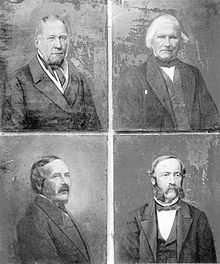Adam Hiorth

Adam Severin Hiorth (16 December 1816 – 20 December 1871) was a Norwegian merchant and industrial pioneer.
Personal life
Hiorth was born in Drøbak as a son of shipmaster Fredrik Wilhelm Hiorth (1776–1844) and Louise Caroline Brodersen (1776–1860s). He died in Aker in 1871.[1]
He married Anne Sofie Sommerfelt (1824–1898) in March 1849 in Lillehammer. She was a daughter of priest and botanist Søren Christian Sommerfeldt (1794–1838),[1][2] and thus a sister of Christian Sommerfelt and Karl Linné Sommerfeldt.[3][4]
He was an uncle of engineer Fredrik Hiorth and the grandfather of painter Agnes Hiorth.[1] A son of Adam Hiorth married Giggi Sommerfelt, a daughter of dean Halfdan Einar Sommerfelt and granddaughter of Hiorth's business partner Ole Gjerdrum.[5]
Career
Hiorth finished school at 14, and then started working as a shop assistant. He was gradually given more responsibilities in the business, and also studied English and French language, and eventually passed the necessary examinations for getting a trading licence. In 1837 he started an agency in groceries and textiles, and in 1841 he co-founded the association Handelens Venner. He travelled to England to study new industrial technologies, in particular the cotton industry in Manchester.[1]
Hiorth co-founded the company Nydalens Compagnie in 1845,[6] along with wholesaler Hans Gulbranson, bailiff Ole Gjerdrum and engineer Oluf Nicolai Roll.[1] The group bought rights to waterfalls of the river Akerselva in the valley Nydalen, where they built a cotton mill and later a weaving mill.[1] Nydalens Compagnie developed into the largest textile company in Norway from the 1890s.[7] It has also been said that Nydalens Compagnie, together with Nedre Vøiens Bomuldsspinderie, signalled the beginning of Norway's industrialization.[8]
Hiorth also founded Christiania Mekaniske Væveri in 1847, together with Gulbranson, Roll, Peter J. K. Petersen and Iver Olsen.[9] In 1857 Hiorth was a co-founder of the association Akerselvens Brugseierforening, a coordinading body for factories exploiting the waterfalls of the river Akerselva. Hiorth chose to resign as manager for the spinning mill in 1860, but was still a member of the board of directors. He was also a joint owner of other textile factories and of the match factory Jølsens Tændstikfabrik, and ran a trading company that imported lamp oil and machinery equipment.[1]
References
- ↑ 1.0 1.1 1.2 1.3 1.4 1.5 1.6 Nerheim, Gunnar. "Adam Hiorth". In Helle, Knut. Norsk biografisk leksikon (in Norwegian). Oslo: Kunnskapsforlaget. Retrieved 4 October 2011.
- ↑ Genealogical entry for Adam Severin Hiorth
- ↑ "Sommerfeldt". Store norske leksikon (in Norwegian). Retrieved 19 May 2012.
- ↑ Jansen, Einar; Jansen, Jonas; Anker, Øyvind; Bøe, Gunvald, ed. (1962). "Sommerfeldt (Sommerfelt) family tree". Norsk biografisk leksikon (in Norwegian) 14 (1st ed.). Oslo: Aschehoug. p. 177.
- ↑ Holst, Ruth Sommerfelt (1922). Stamtavle over slægten Sommerfeldt henholdsvis Sommerfelt. Tillæg av 1922 (in Norwegian). Kristiania: A. W. Brøggers boktrykkeri.
- ↑ Henriksen, Petter (ed.). "Adam Hiorth – forretningsmann og industrigründer". Store norske leksikon (in Norwegian). Oslo: Kunnskapsforlaget. Retrieved 4 October 2011.
- ↑ Henriksen, Petter (ed.). "Nydalens Compagnie". Store norske leksikon (in Norwegian). Oslo: Kunnskapsforlaget. Retrieved 5 October 2011.
- ↑ Myhre, Jan Eivind (1990). Hovedstaden Christiania. Fra 1814 til 1900. Oslo bys historie (in Norwegian) 3. Oslo: Cappelen. p. 257. ISBN 82-02-09144-6.
- ↑ Myhre, 1990: p. 271